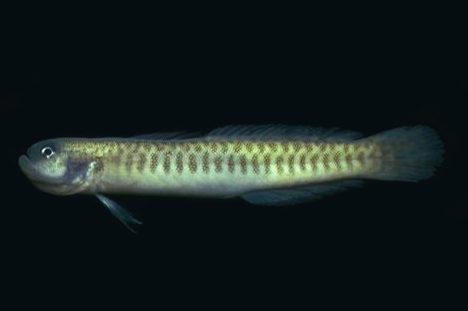Pterocerdale insolita Hoese & Motomura 2009

Pterocerdale insolita, from the type locality - Running Creek Mangrove, Weipa, Queensland. Source: Douglass F. Hoese / Australian Museum. License: All rights reserved
Summary:
A very unusual wormgoby known only from a single specimen collected in Running Creek Mangrove, Weipa, Gulf of Carpentaria, Queensland - collected in 1982.
Cite this page as:
Dianne J. Bray, Pterocerdale insolita in Fishes of Australia, accessed 27 Jun 2025, https://fishesofaustralia.net.au/Home/species/2707
Pterocerdale insolita Hoese & Motomura 2009
More Info
|
Distribution |
Known only from the type locality, Running Creek Mangrove, Weipa, Queensland. |
|
Features |
Meristic features: Dorsal fin VI + I, 19; Anal fin I, 18; Pectoral fin 19; Caudal rays (segmented) 9+8, (branched) 8+7; Pelvic fins separate 1, 4; Vertebrae 26 12 + 14). vertebrae 12+14. Head and body compressed, body elongate; mouth terminal, only slightly protractile, forming an angle of about 60° to longitudinal axis of body; maxilla reaching posteriorly to below front margin of eye; snout relatively short, rounded, its length subequal to eye diameter; anterior nostril at end of short tube; posterior nostril a simple pore. Median nuchal crest, formed by low fold of skin from first dorsal spine onto head, low; gill opening vertical, extending ventrally from pectoral-fin base below upper margin to point just below lower pectoral base, below operculum; fleshy interorbital subequal to diameter of eye. Teeth absent from vomer, tongue and palatines; jaw teeth conical, slightly curved; upper jaw with two rows of small, loosely attached teeth anteriorly, teeth in outer row slightly larger than those in inner row, widely spaced; lower jaw with single row of loosely attached, small teeth directed dorsally, no enlarged curved canines visible in holotype; along outer edge of dentary a series of blunt bony dorsoventrally flattened projections with rounded tip directed more or less horizontally (widely-spaced projections appear to be bony projections of dentary, not true teeth, but probably tooth sockets), space between projections about equal to width of projections; tongue tip broadly rounded. Head pores all paired laterally, with 5 pores around dorsal margin of each eye; head papillae in transverse pattern. Body covered with cycloid scales, imbricate, in 105 vertical rows; nape, cheek, preoperculum and operculum almost fully scaled. |
|
Size |
Only known specimen, 43.5 mm SL (female); 5.1 cm TL. |
|
Etymology |
The specific name is from the Latin insolitus meaning 'strange', 'unusual', 'uncommon', all features of this species. |
|
Author |
Dianne J. Bray |
Pterocerdale insolita Hoese & Motomura 2009
References
Hoese, D.F. & Motomura, H. 2009. Descriptions of two new genera and species of ptereleotrine fishes from Australia and Japan (Teleosei: Gobioidei) with discussion of possible relationships. Zootaxa 2312: 49-59.

